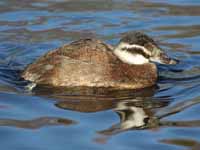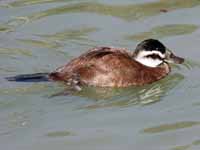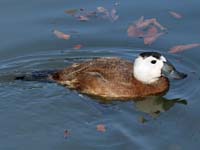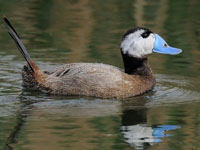The term waterfowl is used to describe any member of the order Anseriformes. A series of articles describes all the waterfowl. This specific article describes the "stiff-tailed ducks " which belong to family Anatidae, subfamily Oxyurinae.
Anseriformes
Most species of the order Anseriformes spend a considerable amount of time in water. In fact, they are called waterfowls. Their webbed feet make for efficient swimming. A few species spend little time in water and thus their feet are only partially webbed. Most waterfowl are also good flyers, many migrating long distances to escape the cold and others migrating shorter distances for optimizing their food supply. All species, except the screamers, have a wide and relatively flat bill. The shape of a species bill and also their tongue is a function of their diet. Considering the entire order, they eat aquatic plants, grasses, sedges, algae, plankton, insects, insect larvae, mollusks, crustaceans, fish, fruits, grains, rice. Most species are monogamous and if they lose a partner seem to mourn. Males are larger and heavier than females. The chicks are well developed when they hatch and can walk almost immediately.
The order Anseriformes has 3 familes: Anatidae, Anhimidae, Anseranatidae. Family Anatidae is comprised of the ducks, swans, and geese which amounts to about 160 species. Family Anhimidae is made up of 3 screamer species while family Anseranatidae has only one species, the magpie goose. Since these latter two families contain so few species, it seems appropriate to consider the entire order in this series of articles.
Anatidae
The Anatidae family has the following subfamiles:
Anatinae: dabbling ducks and teals
Anserinae: geese, swans
Aythyinae: diving ducks
Dendrocygninae: whistling ducks
Merginae: sea ducks
Oxyurinae: stiff-tailed ducks
Plectropterinae: spur-winged goose
Stictonettinae: freckled duck
Tadorninae: shelducks, shelgeese
Stiff-Tailed Ducks
.Most of the stiff-tailed ducks have stiff tail feathers, which are often erect when the bird is at rest. The black-headed duck and the pink-eared duck are exceptions - they do not have stiff-tails.
These are mainly freshwater diving ducks that spend the majority of their life on the water. Their legs are set far back, making them awkward on land, Their unusual displays involve drumming noises from inflatable throat-sacs, head throwing, and erecting short crests. The following genera are considered to be stiff-tail ducks: Biziura, Heteronetta, Malacorhynchus, Nomonyx, Oxyura. All except Oxyura have just one species, the former contains five. Each continent, except Antarctica has a least one species of stiff-tailed ducks.
Most of these ducks exhibit strong dimorphism, the female looking very different from the males during the breeding season. The pink-eared duck is an exception as the sexes are essentially identical in look. But then, the ancestry of the pink-eared ducks is uncertain, perhaps they do not belong in the stiff-tailed duck subfamily. As a rule, the male stiff-tailed ducks are larger than the females. One exception to this rule is the black-headed duck. The blue-billed duck may be another exception, but the data is too limited to make a definitive proclamation.
Many of the species dive to the bottom where there forage in the mud. not being over selective in what the gather, but then sifting the contents with their bill. Some will also occasionally obtain food at the surface; none graze on land. Their diet includes mollusks, crustaceans, aquatic insects, aquatic plants - especially seeds, frogs, and fish. Most stiff-tailed ducks are sedentary, moving due to low water levels or juveniles dispersals. The most energetic migrant is the ruddy duck which migrates from Canada and northern United States to warmer climates.
Genus Heteronetta
The black-headed duck, sole member of genus Heteronetta, is considered to be a basal member of the stiff-tailed duck subfamily. That is, it traces its roots way back in time to before these species developed stiff tails and swollen bills. The black-headed duck does not have a stiff tail. This is the only species of duck that is an obligate brood parasite - the female never builds a nest, but instead always puts its eggs in another specie's nest. Fortunately for the host, the black-headed duck chick leaves the nest within a few hours of birth. So while the host did spend time incubating the invader at least that chick does not kill its litter mates as do many cuckoo species.
Duck,_Black-headed Heteronetta atricapilla
Description: The black-headed duck resembles a typical diving duck, even though it is not in that subfamily. Unlike most ducks, the female black-headed duck is larger than the male. Perhaps this is related to it being the only obligate brood parasitic duck. Both sexes have long bills. The male black-headed duck has a black head, and mantle. The bill is bluish. The female has dark brown upperparts and crown with pale brown face and underparts. The chin is especially pale.
Range: Argentina, Chile, Paraguay.
Habitat: Swamps. lakes, marshes.
Diet: Not much is known. It probably mostly forages by diving, but also dabbles. Food thought to include snails, aquatic plants, insects, seeds.
Conservation status: Least Concern.
Image by: 1) Claudio Timm 2) Pato_Cabeza_Negra- Argentina 3 )Hugo_Hulsberg in Argentina 5) Video by Avibirds. More vidoesRange: Argentina, Chile, Paraguay.
Habitat: Swamps. lakes, marshes.
Diet: Not much is known. It probably mostly forages by diving, but also dabbles. Food thought to include snails, aquatic plants, insects, seeds.
Conservation status: Least Concern.
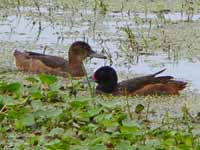
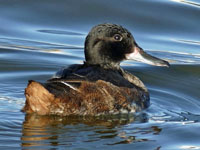

Genus Biziura - 1 species
Duck,_Musk Biziura lobata
Description: The musk duck is dark brown, with paler cheeks. The male has a leathery like appendage underneath the bill. They seldom emerge from the water and even sleep there. On average, they are the second-heaviest diving duck in the world after the common eider.
Range: Australia.
Habitat: Deep, still lakes and wetlands with areas of both open water and reed beds.
Diet: Mollusks, crustaceans, insects, frogs, fish. Also some plant material, especially seeds.
Conservation status: Least Concern. Fortunately for them , musk dusks are not considered to be good for eating, so they are not threatened by hunting.
Image by: 1) Kazredracer 2) JJ Harrison 3) David_Jenkins 4) LeoRange: Australia.
Habitat: Deep, still lakes and wetlands with areas of both open water and reed beds.
Diet: Mollusks, crustaceans, insects, frogs, fish. Also some plant material, especially seeds.
Conservation status: Least Concern. Fortunately for them , musk dusks are not considered to be good for eating, so they are not threatened by hunting.
1) Female with chick 2) Female 3, 4) Male
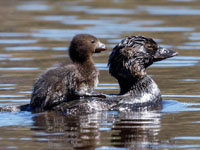
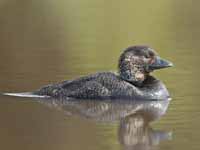
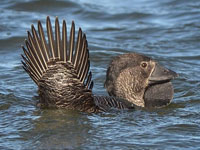
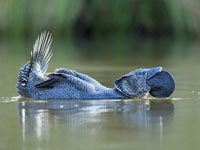
Genus Malacorhynchus - 1 species
All other stiff-tailed ducks are dimorphic, but the pink-eared duck is an exception as the sexes are essentially identical in look. But then, the ancestory of the pink-eared ducks is uncertaain, perhaps they do not belong in the stiff-tailed duck subfamily. In fact, they do not have a stiff tail.
Duck,_Pink-eared Malacorhynchus membranaceus
Description: The Pink-eared Duck has a brown back, black and white barred sides, light colored head with black ear patches, and a large shoveler-like bill. Pink near the eye is difficult to distinguish.
Range: Australia.
Habitat: Anywhere there is standing water.
Diet: Plankton, crustaceans, mollusks, insects.
Conservation status: Least Concern.
Image by: 1) David Jenkins 2) Oystercatcher 3) Laurie_Boyle 4) Elena_GaillardRange: Australia.
Habitat: Anywhere there is standing water.
Diet: Plankton, crustaceans, mollusks, insects.
Conservation status: Least Concern.
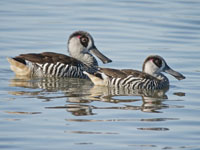

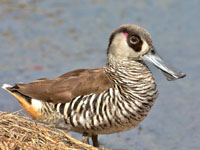

Genus Nomonyx - 1 species
Duck,_Masked Nomonyx dominicus
Description: The breeding male Masked Duck has a rust colored body with a mottled back. The dark face and neck contrasts with the light bill. It has a whitish eye-ring. The female and nonbreeding male have a mottled brownish-grey body and a buff face with 2 dark horizontal stripes. The similar female ruddy duck has just 1 horizontal stripe on the side of her head.
Range: Southern North America, Central and South America.
Habitat: Freshwater with vegetation and surrounded by trees.
Diet: Seeds, roots, and leaves of aquatic plants. Also eat aquatic insects, crustaceans.
Conservation status: Least Concern.
Image by: 1) Richard Crook - Florida 3) Jamie Drake - Florida 2, 3 Felix_Uribe 4) FbioleRange: Southern North America, Central and South America.
Habitat: Freshwater with vegetation and surrounded by trees.
Diet: Seeds, roots, and leaves of aquatic plants. Also eat aquatic insects, crustaceans.
Conservation status: Least Concern.
1) Pair 2, 3) Female 4) Male
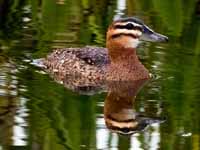
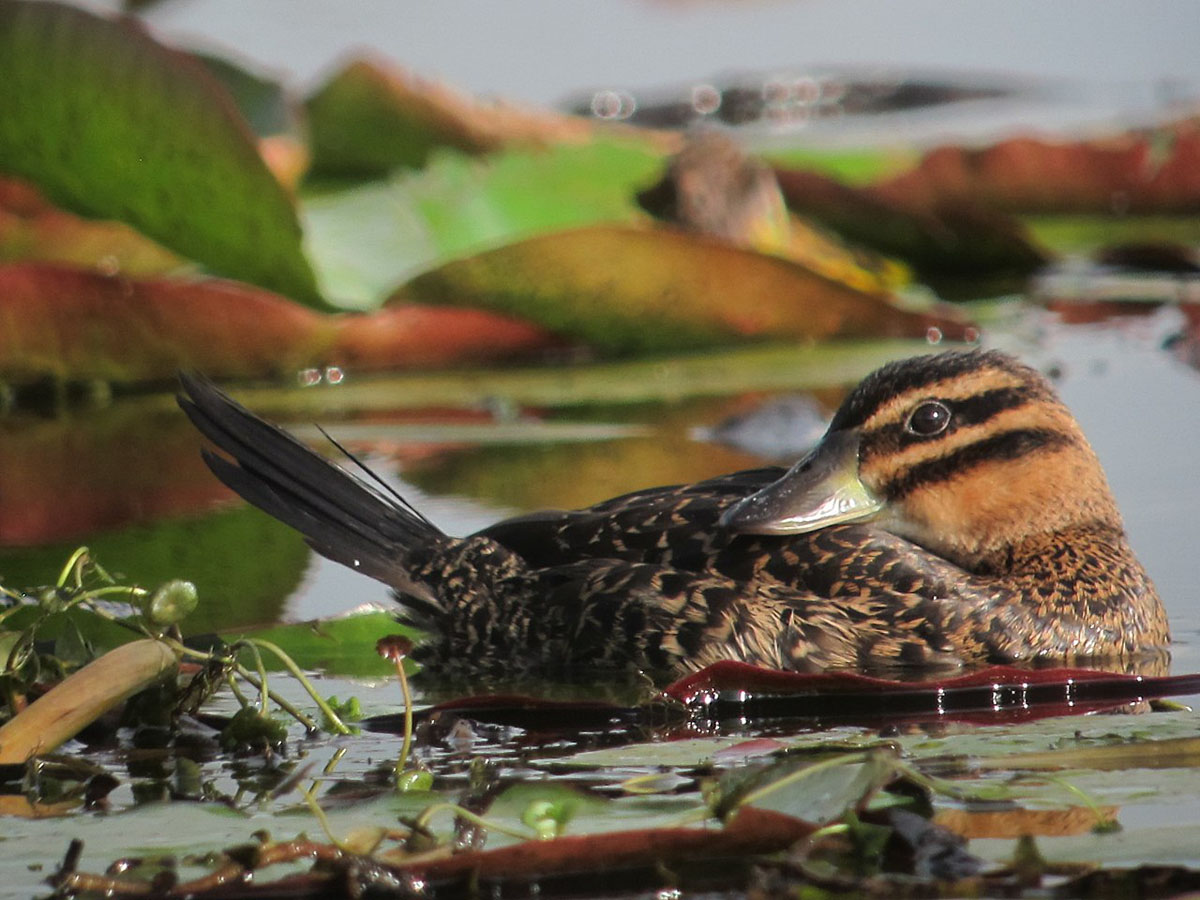
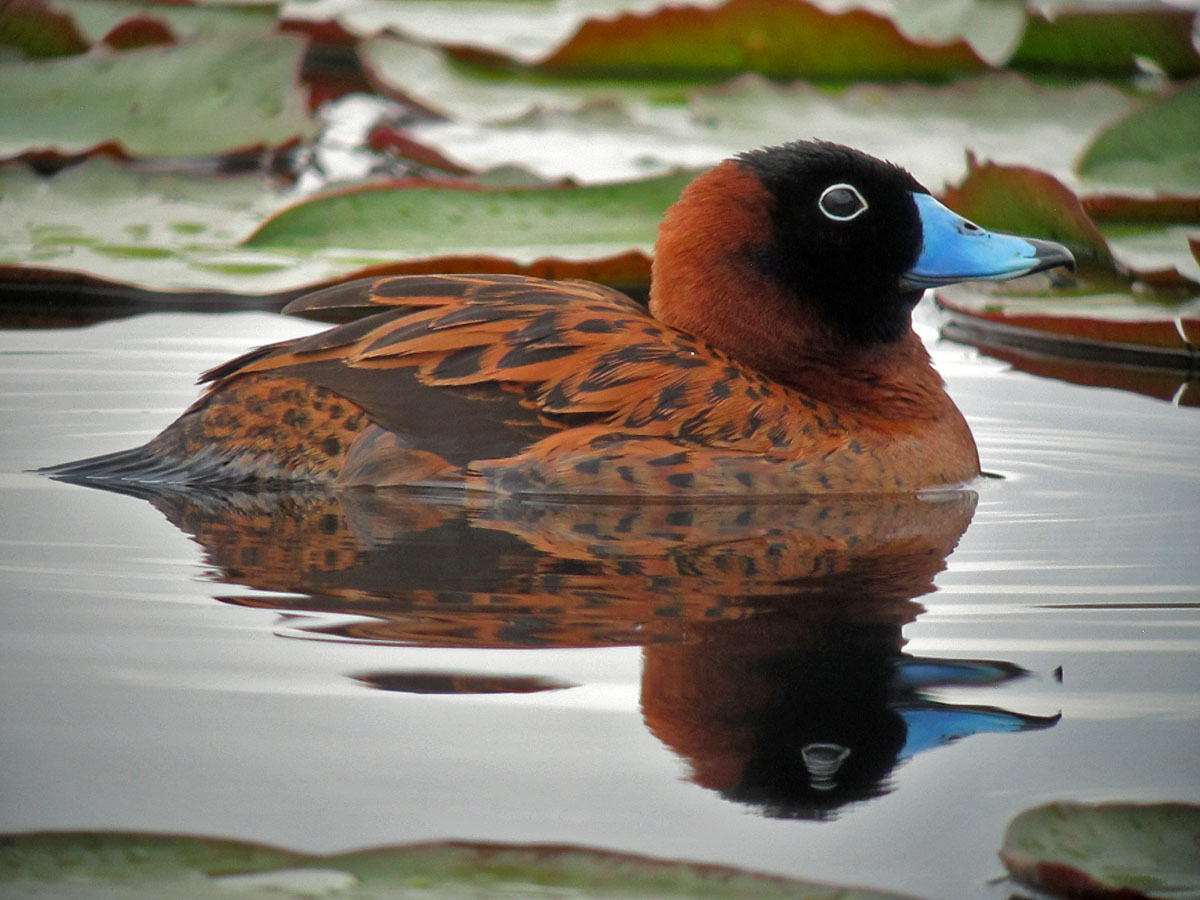

Genus Oxyura
The Oxyura stiff-tail ducks have a stiff tail which is often erect at rest and open in the shape of a fan; large swollen bill; legs set far back so they walk awkwardly and rarely leave the water.
Duck,_Blue-billed Oxyura australis
Description: The male Blue-billed Duck has a blue bill. The head and neck are black, the tail dark brown, the back and underparts are chestnut. It has brown eyes and grey legs. The female is brownish-grey and has a bluish-grey bill.
Range: Australia.
Habitat: Temperate regions in ponds, lakes, swamps. Almost always found in water; walks awkwardly when on land.
Diet: Mollusks, crustaceans, aquatic insects. Forages by sifting mud with its bill.
Conservation status: The blue-billed duck is Near Threatened because of habitat modification through drainage, flood mitigation, water harvesting, and vegetation loss due to clearing.
Image by: 1) Oystercatcher 2) Dick - Sylvan Heights 3) David_Jenkins 4) Jean_and_FredRange: Australia.
Habitat: Temperate regions in ponds, lakes, swamps. Almost always found in water; walks awkwardly when on land.
Diet: Mollusks, crustaceans, aquatic insects. Forages by sifting mud with its bill.
Conservation status: The blue-billed duck is Near Threatened because of habitat modification through drainage, flood mitigation, water harvesting, and vegetation loss due to clearing.
1) Female 2 - 4) Male
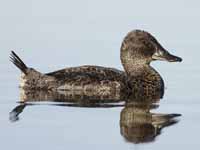
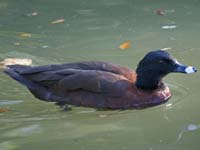
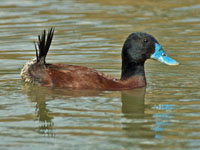

Duck,_Lake Oxyura vittata
Description: The male lake duck, also known as the Argentine blue-bill does have a blue bill. The plumage is mainly chestnut; the head and tail are black. The female has mainly brownish-grey plumage, a dark cap, and a stripe below the eye.
Range: South America.
Habitat: Freshwater ponds and small lakes.
Diet: Forages by swimming to the bottom. Diet not specified, probably mainly plant.
Conservation status: Least Concern.
Image by: 1) Georg Schwalbach 2, 3) Dick Daniels Sylvan Heights Range: South America.
Habitat: Freshwater ponds and small lakes.
Diet: Forages by swimming to the bottom. Diet not specified, probably mainly plant.
Conservation status: Least Concern.
1, 2) Female 3 - 6) Male

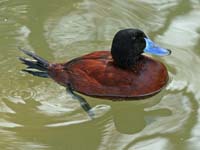
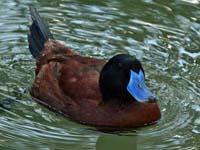
Duck,_Maccoa Oxyura maccoa
Description: The male Maccoa duck has a chestnut body, black head and throat, plus a blue bill. The female has a grey-brown body. The bill, crown, and nape are dark brown. Her face is pale and there is a wide dark eye-line.
Range: Africa (eastern and southern).
Habitat: Fresh or brackish inland waters. During breeding season there must be both open water and emerging vegetation. They prefer to build nests hidden in reeds.
Diet: Aquatic invertegrates and plants. Fills its bill with material from the bottom of the water and then sifts through for desired food.
Conservation status: The Macoa duck is Vulnerable as its population is declining due to decreasing wetlands from global warming.
Image by: 1) Sergey_Yeliseev 2) Monkey_Boy - South AfricaRange: Africa (eastern and southern).
Habitat: Fresh or brackish inland waters. During breeding season there must be both open water and emerging vegetation. They prefer to build nests hidden in reeds.
Diet: Aquatic invertegrates and plants. Fills its bill with material from the bottom of the water and then sifts through for desired food.
Conservation status: The Macoa duck is Vulnerable as its population is declining due to decreasing wetlands from global warming.
1) Female 2) Male
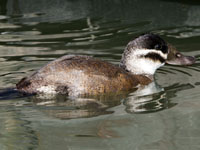
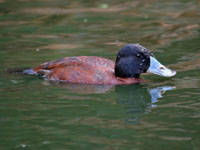
Duck,_Ruddy Oxyura jamaicensis
Description: The breeding male ruddy duck has rust-red body, blue bill, white face, black cap and nape. His non-breeding plumage is duller and the bill is black. The female has a grey-brown body and crown. The face is pale grey with a cheek stripe. The bill is black. She is similar to a female masked duck which has two cheek stripes instead of 1.
Range: Native to North America. Introduced to part of Europe where they are considered an invasive species.
Habitat: Breeds near marshy lakes and ponds that have dense vegetation at the edges. Migrates to unfrozen lakes and ponds plus coastal bays.
Diet: Aquatic insects, mollusks, crustaceans, aquatic vegetation. Forages mainly by diving to bottom and probing the bottom. Occasionally skims material from the surface.
Conservation status: Least Concern.
Image by: 1) Dick - Monterey, California 2, 4) Dick Daniels - Sylvan Heights 3) Alan_WilsonRange: Native to North America. Introduced to part of Europe where they are considered an invasive species.
Habitat: Breeds near marshy lakes and ponds that have dense vegetation at the edges. Migrates to unfrozen lakes and ponds plus coastal bays.
Diet: Aquatic insects, mollusks, crustaceans, aquatic vegetation. Forages mainly by diving to bottom and probing the bottom. Occasionally skims material from the surface.
Conservation status: Least Concern.
1, 2) Female 3) Courting display 4 Nonbreeding male

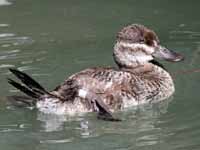
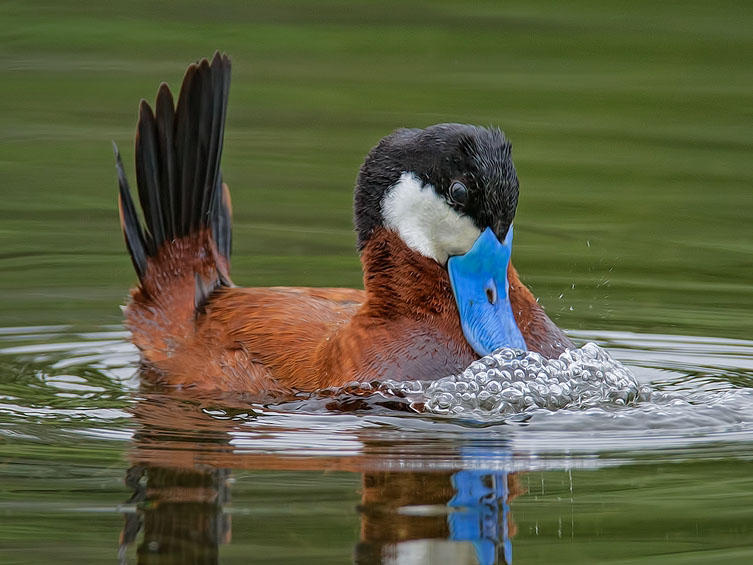
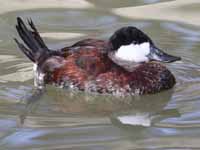
Duck,_White-headed Oxyura leucocephala
Description: The White-headed Duck has a white face and dark cap. The breeding male has a chestnut body, dark blue bill swollen at the base. The nonbreeding male and female have a dark grey bill. The female has a dark eye-line and a less swollen base of bill.
Range: Southern Eurasia, northern Africa.
Habitat: Breeds in fresh or brackish waters with emergent vegetation for nest building and cameflage. Winters in more open waters that may be fresh, brackish, or saline. The saline lakes are used if others of less salt or no salt are freezing.
Diet: Aquatic larvae, crustaceans, plankton, seeds of aquatic plants, aquatic greens. Forages mainly by diving.
Conservation status: The white-headed duck is Endangered due to habitat modification by drainage for developement and lowering of water levels for irrigation.
Image by: 1) Duncan Wright 2, 3) Dick Daniels - Sylvan Heights 4) Andy_Li Range: Southern Eurasia, northern Africa.
Habitat: Breeds in fresh or brackish waters with emergent vegetation for nest building and cameflage. Winters in more open waters that may be fresh, brackish, or saline. The saline lakes are used if others of less salt or no salt are freezing.
Diet: Aquatic larvae, crustaceans, plankton, seeds of aquatic plants, aquatic greens. Forages mainly by diving.
Conservation status: The white-headed duck is Endangered due to habitat modification by drainage for developement and lowering of water levels for irrigation.
1, 2) Female 3, 4) Male 5) Breeding male
